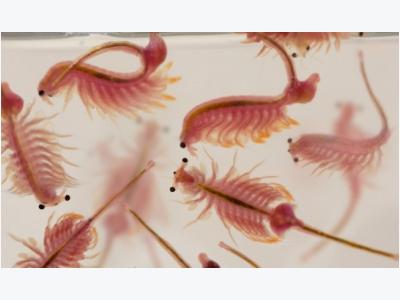Your guide to hatchery larval feed - Zooplankton Week Part 1

Artemia salina. Photo: Reed Mariculture
In part one of our five part sponsored content series, Reed Mariculture gives you the insider's lowdown on what makes a good hatchery larval feed.
Zooplankton -- the microscopic animals that graze on phytoplankton, the single-cell plants of the sea -- are a foundation of fish larviculture, and have long been the essential feed for larval fishes that require live prey, since they cannot survive on formulated feeds.
Although protozoa such as ciliates and trochophore larvae of bivalves have occasionally been used on a small scale, Artemia (brine shrimp), rotifers, and copepods are by far the most commonly-used zooplankton live feeds.
Artemia are in wide use because they are a “convenience food.” Artemia cysts (resting eggs) are harvested in bulk from the wild and preserved by canning. They therefore have a very long shelf-life, so may be stored at the hatchery and the cysts are hatched as needed.
However, Artemia have several shortcomings. Before hatching, the cysts should first be 'decapsulated' using bleach and sodium hydroxide, both to kill pathogens that may contaminate them and to remove the hard shells of the cysts, which can kill larvae if ingested. Even first-stage nauplii are significantly larger than rotifers and so are too large to serve as the first feed for most fish species.
Because Artemia are wild-harvested from habitats that are dominated by algae with limited nutritional value, the cysts and newly-hatched nauplii have an inferior fatty-acid profile compared to rotifers produced on enrichment feeds. Furthermore, first-stage Artemia nauplii are incapable of feeding, so their limited nutritional value rapidly diminishes and they cannot be nutritionally enriched until they molt to the second stage.
Rotifers provide a hardy alternative
Rotifers (various species of Brachionus) are very widely used because they can be mass-produced in the hatchery, thanks to their tolerance of very high culture densities (as high as 5-10 million/liter) and very high reproductive rates that allow them to more than double in numbers each day.
They are also a suitable size for many fish larvae to consume, and they swim slowly and so are easy for naïve early larvae to capture.
They can be fed commercially-available feeds, freeing the hatchery from the need to culture microalgae, and their nutritional content can be optimized by choosing appropriate feeds.
Copepods -- nutritionally better, but harder to produce
Several species of copepods are also used in fish culture. Copepods are more effective because their first-stage nauplii are smaller than rotifers, and they are nutritionally superior. However, they are much more difficult to culture.
Copepods have a longer life cycle (2-3 weeks, in contrast to 2-3 days for rotifers), maximum culture densities are only a few thousand per liter, and the nauplii must be separated from the rest of the culture for feeding to larvae. Unlike rotifers, which can be produced entirely on commercial feeds, many copepod species require live algae cultured in the hatchery as feed.
Who is Reed Mariculture?
Reed Mariculture has supplied microalgal concentrates to the aquaculture industry for over 20 years, and is likewise dedicated to being a dependable supplier of zooplankton.
Reed Mariculture has revolutionized the culturing of rotifers with their marine microalgae concentrates, and is working on ways to do the same with copepods. In fact, the first-stage nauplii of A. panamensis are nearly as small as those of Parvocalanus, and unlike Parvocalanus, A. panamensis can be produced by feeding only Reed Mariculture’s Instant Algae® concentrates --the same feeds that have proven so successful for hatchery production of rotifers.
Hatcheries benefit economically by obtaining zooplankton from the zooplankton specialists at Reed Mariculture as the need arises, rather than having to maintain cultures even when they are not needed. This allows them to devote their resources to the culture of fish, rather than fish feeds, and reduces the need for staffing with algae and zooplankton culture expertise. Hatchery operators also enjoy increased peace-of-mind by knowing that microalgae and zooplankton are readily available in case of culture failures.
Có thể bạn quan tâm
 Vannamei superintensive culture - ORP an essential tool for water quality monitoring
Vannamei superintensive culture - ORP an essential tool for water quality monitoring This is not to sell equipment! ORP test is like a pHmeter pocket meter. Cheap and easy to handle, this parameter can show you what is happening
 Vannamei Superintensive Culture: Growth
Vannamei Superintensive Culture: Growth For better understanding what is growth issue for vannamei we need to analyze two things: water conditioning and feed management.
 Vannamei Superintensive Culture: Aeration
Vannamei Superintensive Culture: Aeration In superintensive vannamei culturing, Aeration setup means how difficult would be your culture if you make a mistake in the water current and sludge spots